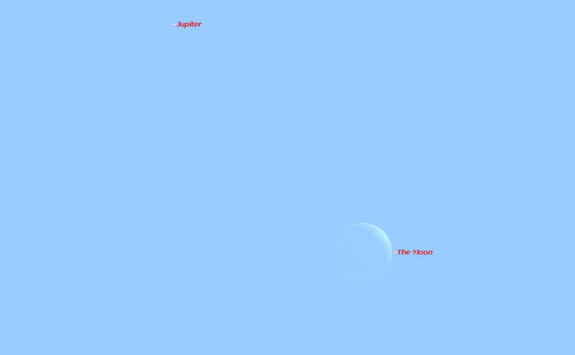Weekend Plans? Try Spotting Jupiter in Daylight
Have you ever seen Jupiter in daylight? This weekend, you just might get your chance.
Very few people have, but you could get an opportunity to join those elite ranks on Sunday (April 14). On that date, the moon will pass close to Jupiter, and can be used to locate the planet in the daytime sky.
Although the daytime sky looks like an unbroken blue blanket on a clear, sunny day, it is actually just as transparent in daylight as it is on a dark night. The difference is that much of the sunlight is scattered by the air molecules in our atmosphere, called Rayleigh scattering. Despite the overall blue cast this gives to the sky, stargazers can still easily see the sun and moon through it.
If you know exactly where to look — and have something to focus your eyes on — you can also see the brighter planets in a blue sky. Venus is easily observed, including the famous incident at Abraham Lincoln's second inauguration, when large numbers in the crowd saw Venus over the Capitol Dome. [Amazing Night Sky Photos for April]
Although it is much larger than Venus, Jupiter is more difficult to spot in daylight because it is farther from the sun. Because of its proximity to the star, it is not as well-lit. When Jupiter is close to the moon, it is easier to spot. The moon shows you where to look, and also gives your eyes something to focus on.
While Jupiter will be visible without optical aid on Sunday, it will be easier to spot first with binoculars. First locate the moon in the south-southeastern sky. Then, look slightly above and to the left of the moon to spot the tiny speck of Jupiter. Once you have spotted Jupiter in binoculars, try the greater challenge of seeing it without optical aid.
If you have a telescope, you can locate Jupiter in the same way.
Amateur astronomers whose telescopes have setting circles or GoTo computers can locate Jupiter any time without needing the help of the moon. Using these methods, you can also observe the planet Mercury and the bright stars Sirius and Procyon in full daylight.
Always remember to use extreme caution when using binoculars or a telescope when the sun is above the horizon. Be especially careful with GoTo telescopes, as these often take quite unpredictable paths across the sky and may catch the sun in passing.
Editor's note: If you snap an amazing photo of Jupiter in daylight or any other stargazing photo you'd like to share for a possible story or image gallery, please contact managing editor Tariq Malik at spacephotos@space.com.
This article was provided to SPACE.com by Starry Night Education, the leader in space science curriculum solutions. Follow Starry Night on Twitter @StarryNightEdu. Original article on SPACE.com.
Copyright 2013 SPACE.com, a TechMediaNetwork company. All rights reserved. This material may not be published, broadcast, rewritten or redistributed.



